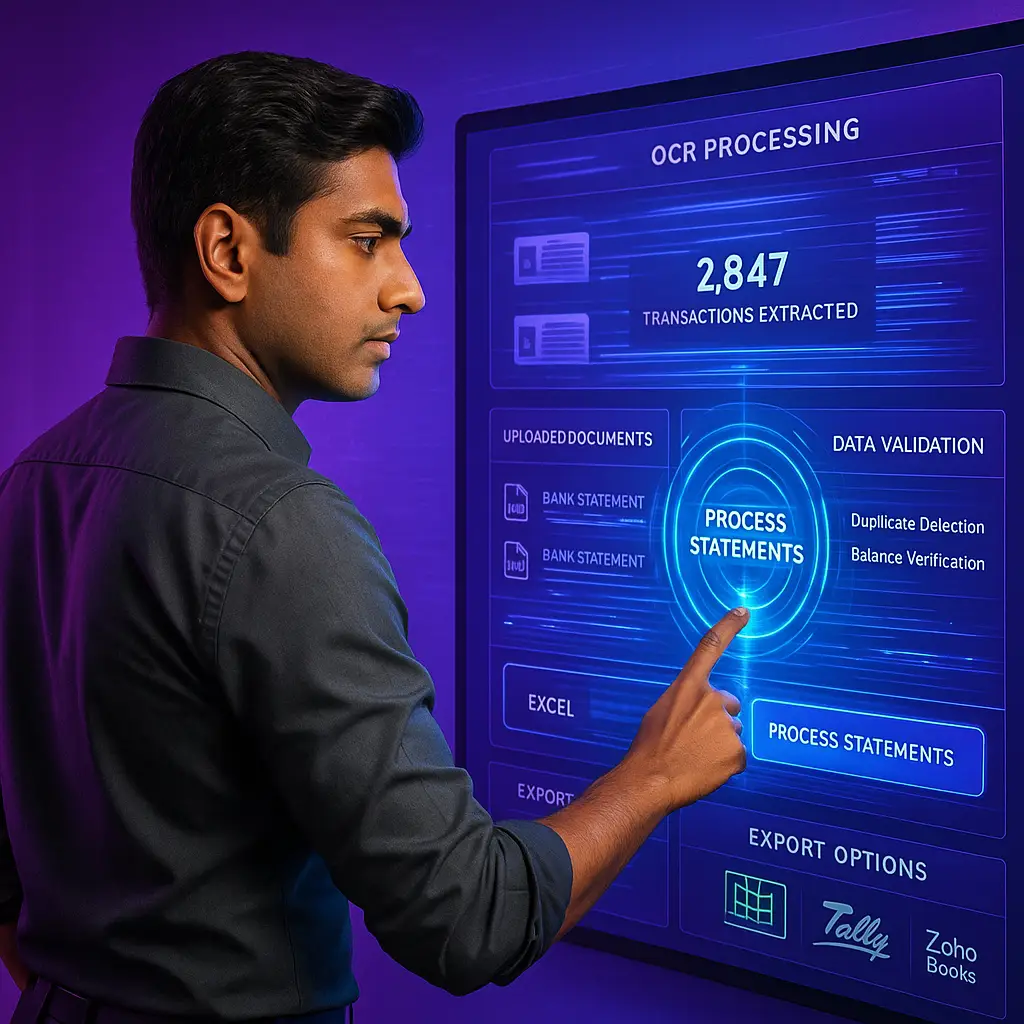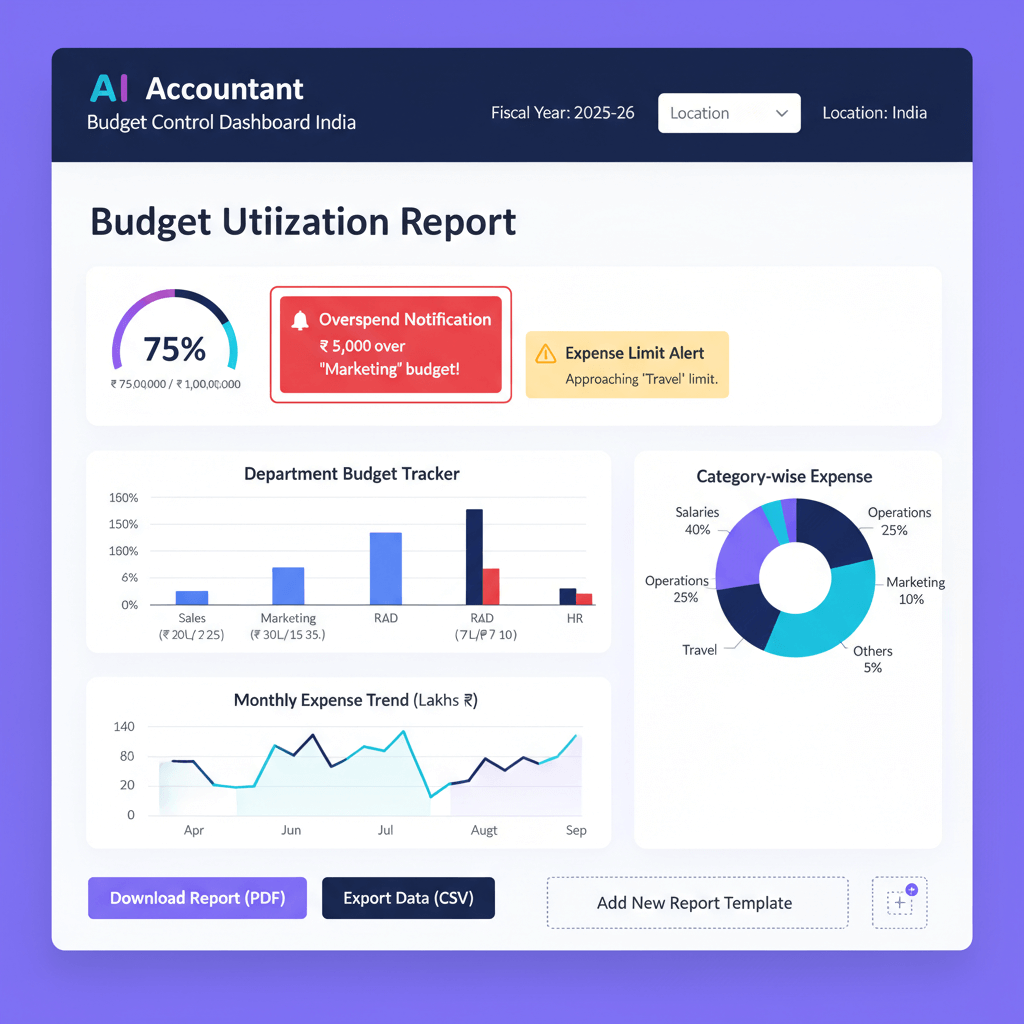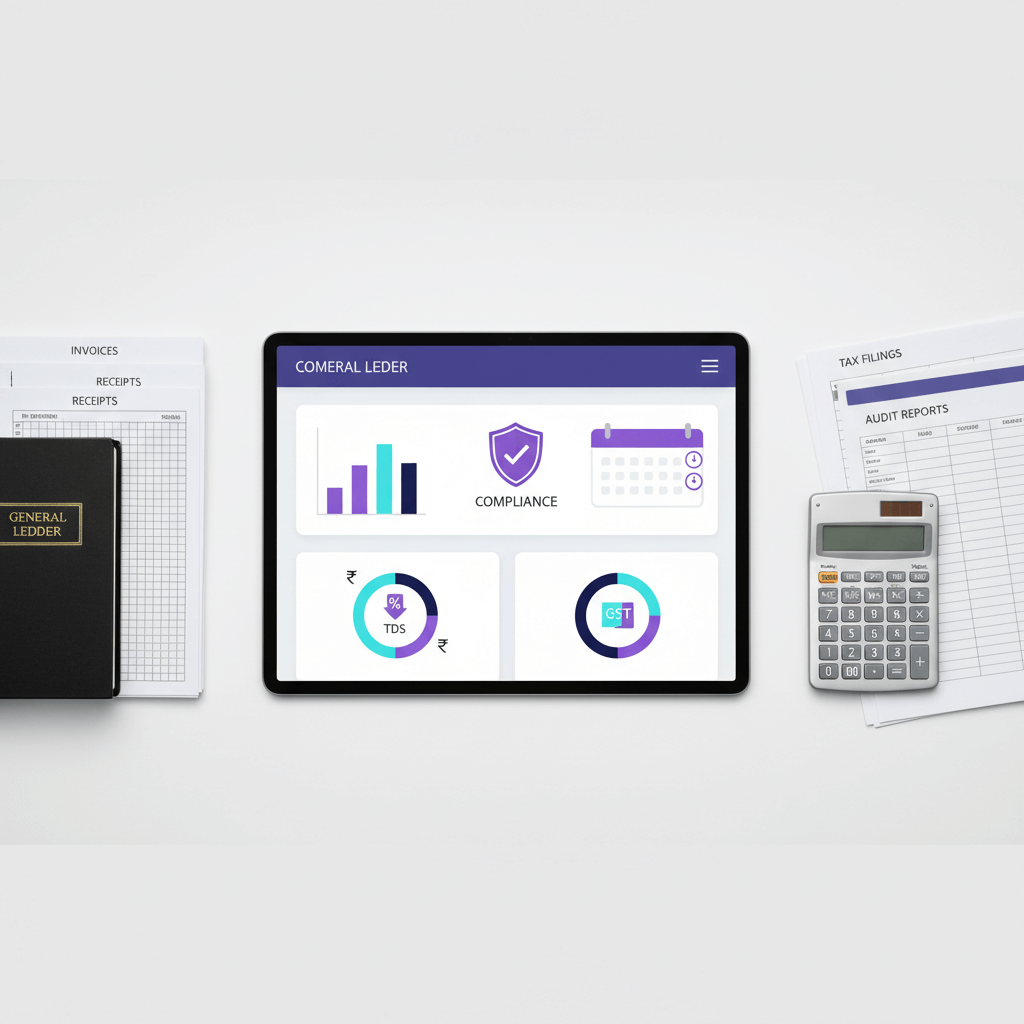Key takeaways
- Indian teams can convert PDF bank statements to Excel with remarkable accuracy and extract transaction data automatically, reducing manual work by 70-80%.
- Top-tier tools handle UPI, IMPS, NEFT, RTGS, bilingual narrations, running balances, and duplicate detection reliably, even on complex multi-bank datasets.
- Demand >98% accuracy on dates, amounts, debit or credit, and running balances, with zero-sum validations and duplicate checks across periods.
- Seamless Tally and Zoho Books integrations turn raw OCR into ledger-ready entries, with audit trails and GST-aware categorization.
- A 7-day, data-driven evaluation plan ensures you select the right platform based on real statements, not demos.
- AI Accountant stands out for India-focused OCR, automation depth, and secure, scalable workflows for CA firms and SMB finance teams.
- Security matters: verify ISO 27001, SOC 2 Type 2, data residency, and access controls before you commit.
Table of contents
- Why Indian Teams Need Bank Statement OCR Now
- What Is Bank Statement OCR for India and How It Works
- India Specific Complexity That Tools Must Handle
- Buying Criteria Checklist for Accurate Bank OCR Tools
- Hands On Demo: How to Convert PDF Bank Statements to Excel
- Beyond OCR: From Raw Data to Ledger Ready Entries
- Shortlist of Accurate Bank OCR Tools for India
- 7 Day Evaluation Plan for CAs and Finance Teams
- ROI and Operational Impact
- Where AI Accountant Fits in Your Workflow
- Common Pitfalls and How to Avoid Them
- Taking the Next Step
- FAQ
Why Indian Teams Need Bank Statement OCR Now
It is 6 PM on month end, your team is still typing transactions from 50 plus statements. With UPI crossing 10 billion monthly, and clients holding accounts across SBI, HDFC, ICICI, Axis, Kotak, and more, manual entry is no longer viable. SMBs easily generate 1,000 plus lines a month across accounts, CA firms managing 50 plus clients can face tens of thousands of rows.
Teams using bank statement OCR software India solutions report up to 75% reduction in manual classification, turning 8 hour grinds into 2 hour workflows. The tipping point is here: automation is now business critical.
Manual data entry is error prone, slow, and unscalable. Automation preserves accuracy, enables on time filings, and frees capacity for advisory.
But not all tools understand India specific complexity. Generic OCR stumbles on UPI VPAs, bilingual narrations, and bank specific layouts. The right tool must be trained on Indian data, and validated for running balances, duplicates, and GST aware categorization.
What Is Bank Statement OCR for India and How It Works
Bank statement OCR for India combines advanced OCR engines, layout understanding, and NLP trained on Indian bank formats. Unlike brittle templates, modern ML models adapt to layout changes, handle crisp e-statements and tough passbook scans, and keep accuracy stable across varying qualities.
The magic is in post processing: date normalization, debit or credit interpretation, running balance validation, opening or closing balance checks, and duplicate spotting across overlapping periods. Tools that detect and flag duplicate transactions protect your books proactively.
Next level systems derive intelligence from narrations, identifying vendors, payment modes, and even GST suggestions.
India Specific Complexity That Tools Must Handle
Format diversity across SBI, HDFC, ICICI, Axis, Kotak, Yes Bank, IDFC FIRST, Federal, Canara, and BoB, plus passbooks and business account variants, means hundreds of templates. See this multi-bank account reconciliation guide for context.
Transaction type complexity includes UPI VPAs, IMPS UTRs, NEFT and RTGS beneficiary details, POS merchant codes, NWD, CMS, CHQ, DD, REV CHG, INT CR, FX fees, and more. Reference the hidden bank charges detection in India playbook to catch subtle fees.
Language and encoding challenges, bilingual narrations, and Unicode symbols demand robust NLP to extract vendors and purposes correctly.
Technical constraints like password protected PDFs, low quality scans, multi page running balances, masked account numbers, and overlapping headers require resilient pipelines that maintain integrity end to end.
Buying Criteria Checklist for Accurate Bank OCR Tools
- Accuracy benchmarks: target >98% on dates, amounts, D or C, running balances, with zero sum validations and cross period duplicate detection.
- Indian bank coverage: confirm support for 20-50 plus major formats, test with your real statements before committing.
- Export flexibility: the ability to convert PDF bank statements to Excel with remarkable accuracy, with custom column mapping, CSV, JSON, and ledger ready formatting.
- Automation depth: NLP powered categorization, vendor detection, GST suggestions that extract transaction data automatically beyond raw OCR.
- Integrations: seamless Tally and Zoho Books sync, with bi directional matching and posting.
- Security: ISO 27001, SOC 2 Type 2, data residency, access controls, and audit trails.
- Operational readiness: batch processing, APIs, rate limits, monitoring, SLAs, and responsive support.
- Pricing clarity: understand per page or per statement or per company models, and hidden fees like setups or reprocessing.
- Proof: insist on sample outputs, accuracy reports, references, and live demos, backed by an automated bank reconciliation in India workflow.
Hands On Demo: How to Convert PDF Bank Statements to Excel
Prepare your test dataset: include password protected PDFs, multi page statements, scanned passbooks, and at least 5-8 banks. Stress test real world complexity, not just glossy samples.
Upload and configure: set DD or MM date formats and currency, ensure password prompts are smooth.
Validate previews: verify D or C signs, reconcile opening and closing balances across pages, confirm complete narrations, and check consistent running balances.
Export testing: when you convert PDF bank statements to Excel with remarkable accuracy, run sum checks, build pivots by transaction type, confirm date formats, and watch for missing or duplicated rows.
Integration testing: push categorized entries into Tally or Zoho Books, verify vendor names, ledgers, and GST codes align with your chart of accounts.
Error handling: test missing pages, corrupted PDFs, unusual transaction types. Prefer tools that flag issues explicitly, not silently.
Document accuracy rates, manual edits, and processing times. Your own KPI sheet beats any sales deck.
Beyond OCR: From Raw Data to Ledger Ready Entries
Intelligent vendor detection: parse UPI VPAs, IFSCs, POS IDs, and NEFT or RTGS fields to resolve suppliers and payees.
Automated categorization: ML suggests ledger heads and GST codes from patterns, keeps recurring items consistent, flags anomalies for review.
Invoice and bill linking: match bank lines to open invoices in Tally or Zoho Books automatically.
Exception management: keep queues for bounced cheques, bank charges, refunds, EMIs, intercompany transfers, FX. Use the suspense account clearing guide for policy design.
Duplicate handling: safely merge overlaps across statement periods. See the end to end flow in automated bank reconciliation in India.
Shortlist of Accurate Bank OCR Tools for India
AI Accountant by Karbon Card
India focused OCR and NLP across major banks, one click Tally and Zoho Books sync, GST aware categorization, dashboards, and enterprise security. Especially strong for CA firms and SMB finance teams needing end to end automation from OCR to ledger posting.
Docsumo
API first document AI with strong bank statement parsing, classification, and verification flows. Suitable for high volume and multi document workflows. Explore their verification approach in the data verification API guide.
Perfios Bank Statement Analyzer
BFSI grade coverage and analytics with risk scoring and fraud detection, ideal for lending and underwriting contexts.
Karza and Signzy type analyzers
Integrated KYC plus statement parsing for onboarding and compliance workflows, useful for fintechs and regulated institutions.
Zoho Books and Tally ecosystem add ons
Native parsers inside familiar systems, good for simpler needs and low volumes where ease of adoption matters. For market context, see this overview of bank statement analysis software.
7 Day Evaluation Plan for CAs and Finance Teams
Days 1-2: compile a tough dataset, set pass or fail thresholds, and baseline current manual time. Target >98% accuracy on core fields, perfect zero sum, and running balance continuity.
Days 3-4: batch process through each tool, measure accuracy, reconcile success, and log failure modes. Note processing speeds and required interventions.
Day 5: export to Excel, CSV, JSON, validate totals, pivots, date order, duplicates, and mapping flexibility.
Day 6: test Tally and Zoho Books sync, invoice matching, ledger or GST suggestions, audit trails, and graceful error handling.
Day 7: complete security due diligence, confirm certifications, data policies, access controls, SLAs, and pricing. Decide using your metrics, not feature lists.
ROI and Operational Impact
- Direct time savings: 70-80% less data entry, 50-60% less classification effort, reclaiming 40-50 hours per 10,000 lines monthly.
- Error reduction: drop manual errors from 2-5% to under 2%, accelerate month end reconciliation.
- Capacity growth: serve 30-40% more clients without proportional hiring, free capacity for premium advisory.
- Compliance efficiency: faster GSTR prep with GST aware tagging, less crunch time.
- Cash flow visibility: near real time dashboards for receivables, expense patterns, and runway, enabling proactive advice.
- Differentiation: real time reporting supports higher service tiers and 20-30% fee uplifts.
Where AI Accountant Fits in Your Workflow
AI Accountant acts as a quiet assistant for Indian bookkeeping, trained on local banking nuances from UPI narrations to regional formats. It removes grunt work, keeps humans in the loop, and posts clean entries with full audit trails through one click Tally and Zoho Books integration.
Dashboards surface revenue and expense trends, cash flows, AR aging, and vendor analysis. With 180 plus customers, 50 plus CA firms, and 300 plus million processed transactions, the platform blends accuracy, scalability, and security, backed by ISO 27001 and SOC 2 Type 2.
See how it ties together with automated bank reconciliation in India workflows.
Common Pitfalls and How to Avoid Them
- Debit or credit sign confusion: banks differ on D or C conventions, verify mapping during pilots.
- Date format mix ups: enforce DD or MM explicitly, spot check chronological order in exports.
- Duplicate pages: watch for repeats in scanned bundles, insist on automatic de duplication and running balance checks.
- Running balance breaks: multi page sequences can slip, require continuity and zero sum validation. See the bank reconciliation statement automation guide.
- OCR quality issues: poor scans need preprocessing and, occasionally, manual review.
- Password handling: ensure secure unlock flows without storing credentials unnecessarily.
- Corrupted or incomplete files: good tools detect and flag, not silently pass.
Taking the Next Step
Adopting bank statement OCR software India solutions transforms your month end from typing to analyzing. Begin with the 7 day plan, test with your toughest statements, and decide using measured accuracy, speed, and integration depth. The best system disappears into your workflow, while your expertise takes center stage.
FAQ
As a CA, how do I verify that an OCR tool truly understands Indian bank formats before I roll it out?
Run a pilot on a curated dataset that includes SBI, HDFC, ICICI, Axis, Kotak, and at least two regional banks, mix e-statements and scanned passbooks, include password protected PDFs, and multi page sequences. Demand >98% accuracy on dates, amounts, D or C, and running balances, and require zero sum and duplicate detection across overlapping periods. Document corrections and processing times to compare vendors objectively.
What is the most reliable method to convert PDF bank statements to Excel with running balance integrity for audit readiness?
Use a tool that performs page sequence control, opening or closing balance reconciliation, and zero sum checks, then export to Excel and validate with sum formulas and pivots. Solutions trained for India, such as AI Accountant, deliver ledger ready Excel with consistent date formats and unbroken running balances, minimizing downstream corrections.
Can I pipe OCR results directly into Tally without manual touch, or should I keep an approval step?
Direct posting is possible through bi directional integrations, however best practice is a lightweight approval queue for low confidence items or exceptions. AI Accountant supports fetch and match against existing vouchers in Tally, suggests ledgers and GST codes, then lets you approve or auto post based on confidence thresholds.
How do Indian transaction types like UPI, IMPS, NEFT, and POS get categorized consistently by AI?
Advanced NLP models parse narrations for VPA handles, UTRs, IFSCs, and merchant IDs, then map to standardized categories and suggest GST codes. Over time, the model learns from your corrections, so recurring strings like rent, fuel, or utilities become consistent, while anomalies are flagged for review.
We process 25,000 plus lines a month across 40 clients. What operational metrics should I track during evaluation?
Track field level accuracy, reconciliation success rate, duplicate detection rate, average processing time per page, exception rate, manual edit time per 1,000 rows, and integration success with Tally or Zoho. Also track uptime, API throughput, and SLA adherence. These metrics quantify ROI and de risk scale up.
How are password protected bank PDFs handled securely in production workflows?
Use bulk password rules or prompts at upload, ensure ephemeral decryption in memory, avoid storing passwords, and restrict access via role based permissions. Audit logs should record access, actions, and exports. AI Accountant supports secure unlock flows aligned with ISO 27001 and SOC 2 controls.
Will OCR cope with scanned passbooks and low resolution images from legacy banks?
Yes, if the platform includes image preprocessing, de skewing, denoising, and adaptive thresholding. Expect slightly lower accuracy than e-statements, often 95-97%, so keep a focused review queue for low confidence fields. Over time, vendor retraining on your samples can lift accuracy.
How do I prevent duplicate transactions when clients send overlapping monthly statements?
Choose a tool that fingerprints transactions using date, amount, narration, and running balance neighbors, then suppresses repeats on import. Systems like AI Accountant run cross period duplicate checks and provide a duplicate report, ensuring clean ledgers without manual filtering.
What GST specific benefits can AI driven bank parsing deliver during GSTR prep?
Auto classification by tax relevant categories, vendor detection to match GSTIN directories, recognition of bank charges and fees for ITC eligibility decisions, and consistent HSN or SAC suggestions for recurring payments. This reduces review cycles and speeds GSTR reconciliation materially.
How should a CA firm compute ROI on bank statement OCR adoption with real numbers?
Multiply hours saved per 1,000 lines by your blended hourly rate, add increased client capacity from freed bandwidth, and subtract reduced error correction time and filing overtime. Include soft benefits like faster MIS, better cash flow visibility, and advisory upsell potential. Many firms see payback within 1-2 months.
Do we need separate tools for risk analysis and routine bookkeeping, or can one platform serve both?
For underwriting and fraud analytics, specialized platforms like Perfios or verification APIs may be preferable. For daily bookkeeping, reconciliation, and Tally or Zoho workflows, a focused India centric tool such as AI Accountant is optimal. Some firms run both, connected via exports or APIs.
What governance controls should I put in place before enabling auto posting to ledgers?
Define confidence thresholds, segregation of duties for approval, exception queues for high value or unusual transactions, versioned mapping rules, and periodic accuracy audits. Ensure immutable audit trails for imports and postings, and enable maker checker on sensitive ledgers like bank charges, suspense, and intercompany.

-01%201.svg)



